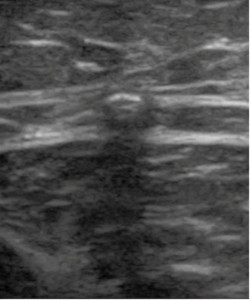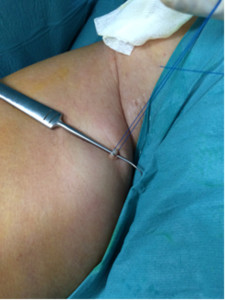Combined modalities are gaining popularity for the treatment of varicose veins. The aim is to provide a more complete treatment at the primary procedure which may not be possible using a single technique. The commonest example is endothermal ablation with concurrent phlebectomies (varicose vein removal). In this set-up both the refluxing saphenous trunk is treated as well as the varicose veins which are pressurised by this trunk. Another example is endothermal ablation with concurrent foam sclerotherapy (chemical destruction of the varicose veins).
A novel technique is described which combines 2 modalities for the treatment of the great saphenous vein (GSV) namely, ultrasound guided foam sclerotherapy (UGFS) and percutaneous ligation (PL).
LARS HERLUF RASMUSSEN Ultrasound guided foam sclerotherapy is inexpensive but less durable than thermo-ablation with laser or radiofrequency because of increased recanalisation. This means that the GSV re-opens with the potential to pressurise the draining tributaries and cause recurrence of the varicose veins. Adding percutaneous ligation (PL) to the procedure might reduce recanalization and therefore reduce the chance of recurrent varicose veins. We have treated over 70 legs in patients with varicose veins arising from saphenous reflux using UGFS + PL + mini-phlebectomies, under local anaesthetic. The procedural details are described:
Foam was prepared using polydocanol 3% in a concentration of 1 mL + 4 mL of air. This was injected into the refluxing saphenous trunk using Venflons®. This was followed by percutaneous ligation performed through a 5 mm incision approximately 2 cm below the sapheno-femoral junction. Ultrasound was used to locate the terminal segment of the GSV. Next, this was lifted up through the skin incision with an Oersch® phlebectomy hook. Then the GSV was ligated with a non-absorbable nylon tie. Finally, mini-phlebectomies were performed to complete the treatment.
All patients were reviewed at 3 months. Success was achieved in terms of saphenous closure (94%), patient satisfaction (99%) and absence of venous symptoms (96%).
Foam sclerotherapy with saphenous ligation is a promising treatment modality which has the potential to reduce the recurrence rate of varicose veins. It can be performed on the small saphenous vein as well as the GSV. The procedure of PL is simple and quick. The results are similar to glue or thermo-ablation but the procedure is much cheaper and still minimal invasive
Typical appearance of foam within the GSV demonstrated by a transverse ultrasound scan. Foam is visualised as a hyperechoic crescent within the saphenous fascia casting a broad acoustic shadow.
The terminal segment of the GSV has been lifted up though a small skin incision in preparation for percutaneous ligation.

